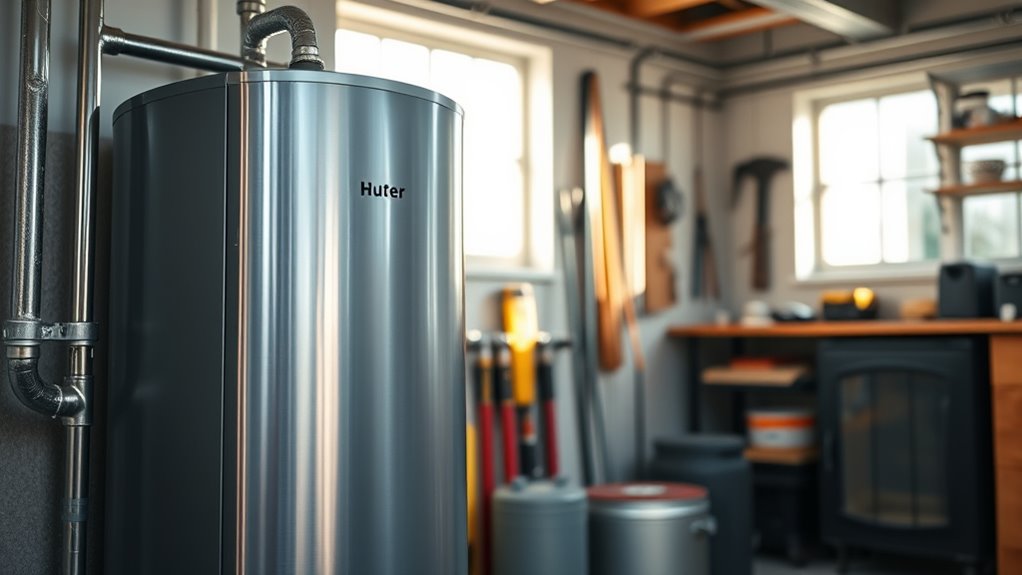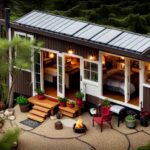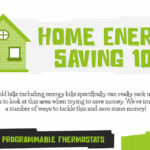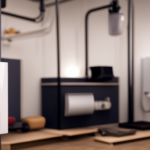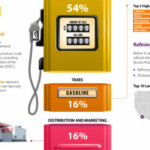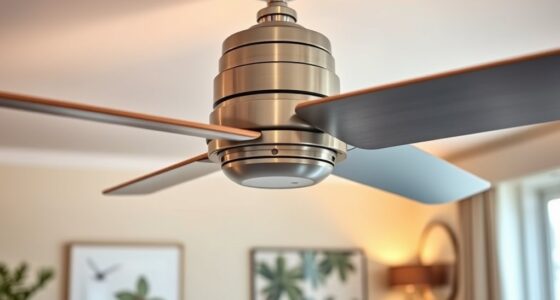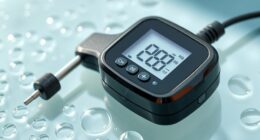Heat pump water heaters cut your energy bills by using ambient air to generate hot water more efficiently than traditional units. They consume about 117 kWh annually, saving you up to $550 each year compared to electric resistance models. They also reduce greenhouse emissions and improve indoor air quality. With government incentives and growing market adoption, these silent, eco-friendly units are transforming home energy use. Keep exploring to discover how you can benefit from this leading technology.
Key Takeaways
- Heat pump water heaters are highly energy-efficient, reducing utility bills by up to $550 annually compared to traditional models.
- They utilize ambient air heat, significantly lowering electricity consumption and carbon emissions.
- Proper installation and maintenance optimize savings and ensure quiet operation, debunking the “silent killer” myth.
- Incentives and rebates lower upfront costs, accelerating adoption and expense savings.
- Widespread use can eliminate over 100 million tons of U.S. CO2 emissions annually, benefiting the environment and your wallet.
How Heat Pump Water Heaters Slash Energy Costs
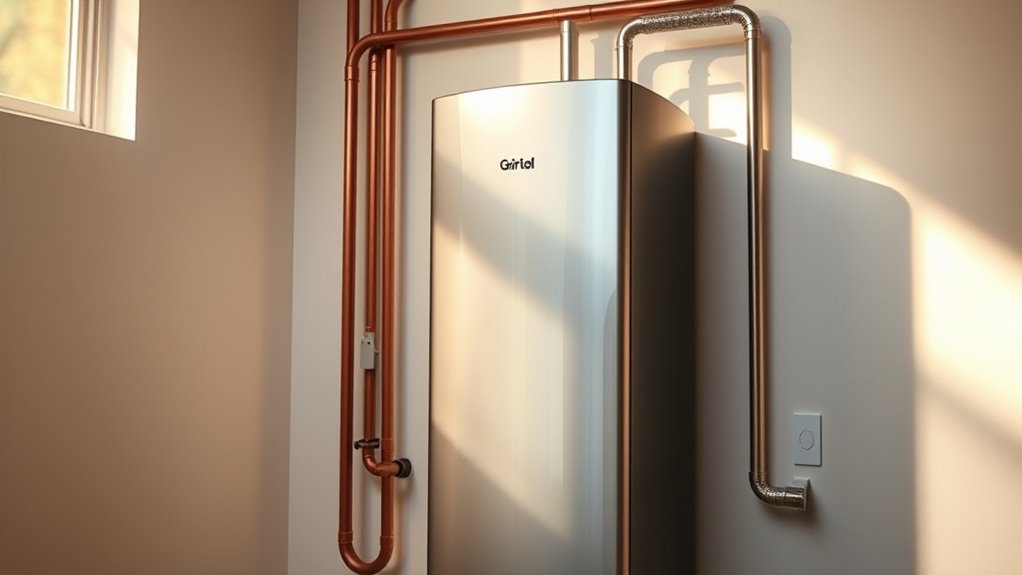
Heat pump water heaters substantially reduce your energy costs by using electricity more efficiently than traditional systems. They operate with 2-4 times higher efficiency because they move heat instead of generating it directly. On average, each unit saves about 1,654 kWh annually, translating into lower utility bills. For a household of four, this can mean savings of around $550 per year compared to electric resistance heaters and $200 compared to gas water heaters. HPWHs consume roughly 117 kWh per year for operation, much less than the 325 kWh used by gas models. Their growing popularity—shown by a 26% sales increase in 2022—reflects consumer trust in their cost-saving potential. These efficiencies help keep your household bills low while providing reliable hot water. Additionally, tuning options for HVAC systems can further optimize energy consumption and enhance overall efficiency.
The Environmental Benefits of Switching to HPWHs
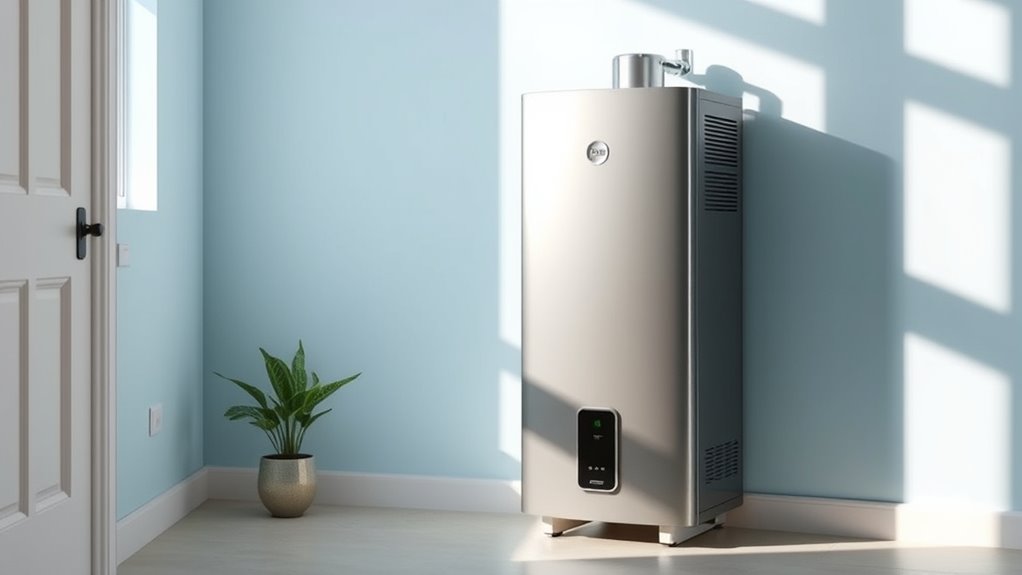
Switching to heat pump water heaters (HPWHs) offers significant environmental advantages by drastically reducing greenhouse gas emissions. They cut about 2,000 pounds of CO2 annually compared to traditional fossil fuel models by using ambient air heat instead of burning fuel. This shift also significantly reduces household reliance on fossil fuels, supporting a cleaner energy future. Widespread adoption could eliminate over 100 million tons of U.S. carbon emissions each year. HPWHs also improve indoor air quality by removing combustion byproducts like carbon monoxide. Their high energy efficiency—two to three times better than conventional heaters—reduces overall energy consumption, saving the equivalent of six solar panels annually. Installing an HPWH can offset roughly 12 tons of CO2 over its lifespan, comparable to planting 17 trees each year. As grid electricity becomes cleaner, these benefits will only grow, supporting broader climate goals. Additionally, increased adoption of HPWHs can promote energy grid stability by reducing peak electricity demand during high-usage periods.
Market Growth and Adoption Trends
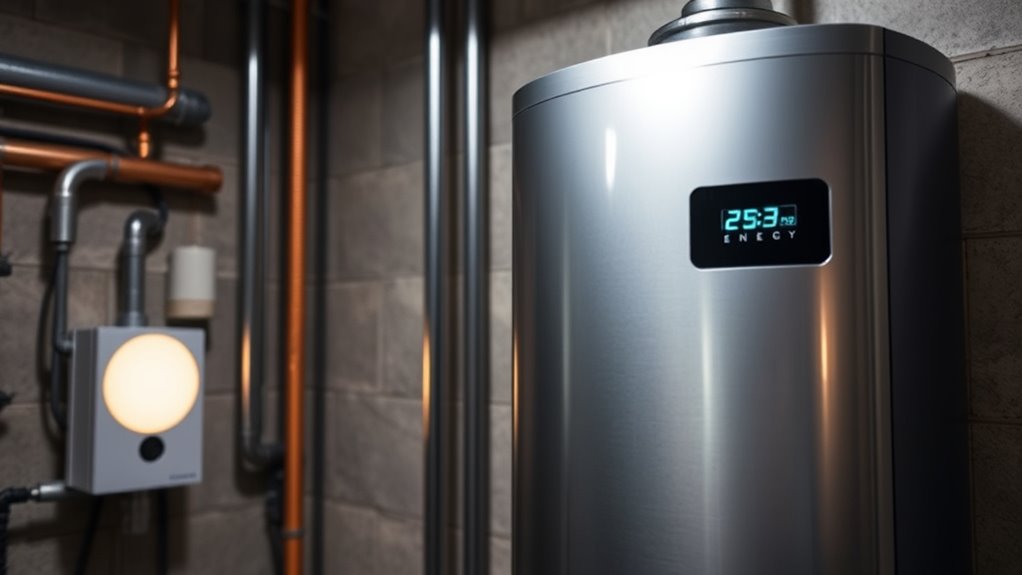
The global market for heat pump water heaters is experiencing rapid growth, driven by increasing demand for energy-efficient and environmentally friendly solutions. Here’s what’s fueling the trend:
- The market is valued at around USD 12.87 billion in 2024 and is projected to hit USD 25.16 billion by 2030, with a CAGR of 12.1%.
- In the U.S., revenue is expected to grow from $2.45 billion in 2024 to $2.66 billion in 2025, and reach $3.6 billion by 2029.
- Adoption is boosted by government incentives, energy efficiency goals, and rising energy costs.
- Despite only 2.1% of water heater sales being HPWHs in 2023, projections suggest they could account for up to 40% by the end of the decade.
- Extensive research supports the adoption of heat pump water heaters due to their energy efficiency, which plays a key role in reducing operational costs and environmental impact.
Comparing Operating Expenses: HPWHs vs. Traditional Heaters
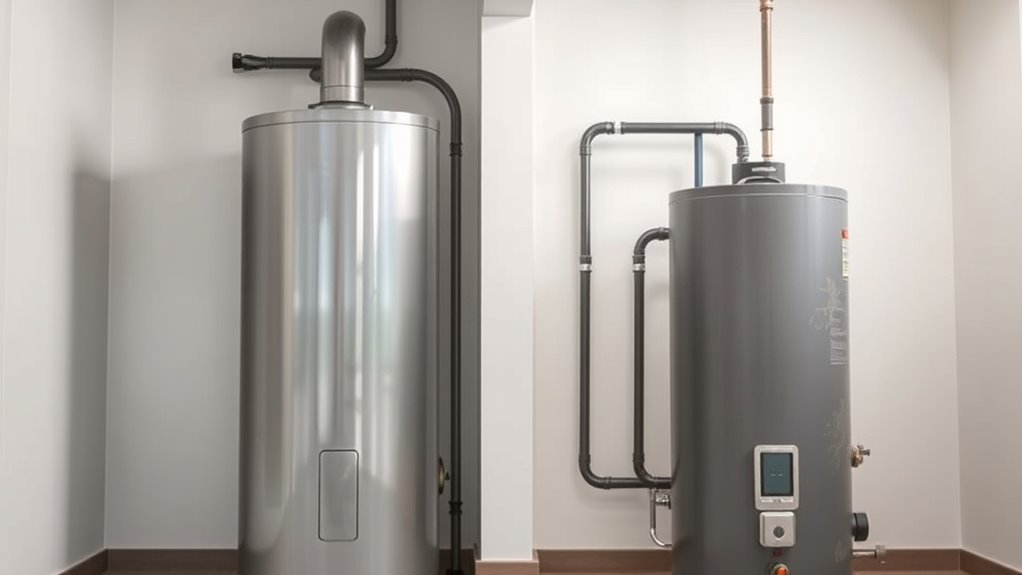
You can save considerably on energy bills with heat pump water heaters (HPWHs) compared to traditional models, thanks to their higher efficiency. While HPWHs have higher upfront costs and installation expenses, those are often offset by lower operating expenses over time. Incentives and regional energy prices can further influence which option is more cost-effective for you. Factors influencing operating costs, such as energy source prices and efficiency ratings, play a significant role in determining the long-term savings. Additionally, understanding the energy efficiency ratings of different models can help optimize your savings over the lifespan of the heater.
Operating Cost Differences
Ever wondered how much money you can save by choosing a heat pump water heater (HPWH) over a traditional electric model? The difference is significant. Here’s what you need to know:
- HPWHs typically cost about $90 annually to operate, compared to $230 for conventional electric heaters.
- They can save you up to $550 each year on energy costs thanks to their higher efficiency.
- Operating costs depend heavily on your local electricity rates, which can vary widely.
- HPWHs transfer heat instead of generating it, making them far more efficient and cost-effective over time. Their efficiency ratings, around 2, indicate they use energy much more effectively than traditional models.
- Proper installation and system maintenance can further optimize their savings and performance.
Switching to a HPWH can drastically reduce your energy bills, turning a hidden expense into long-term savings.
Impact of Incentives
Have you considered how incentives can considerably impact the overall cost difference between heat pump water heaters (HPWHs) and traditional electric models? Federal tax credits can cover up to 30% of your project costs, with a maximum of $2,000 per installation, making the upfront expense more manageable. Utility rebates, like SMUD’s up to $3,000, and programs from EWEB can further cut costs, sometimes reducing purchase prices to under $1,000. These incentives often stack, especially when combined with statewide programs, helping you lower the initial investment. Proper installation and compliance with program requirements ensure you maximize your rebate and tax credit benefits. Additionally, understanding energy efficiency standards can help you select the most cost-effective and compliant units. Reduced upfront costs mean shorter payback periods and lower overall expenses. By taking advantage of these incentives, you can make the switch to a more energy-efficient system without breaking the bank, ultimately saving more on operating costs over time.
Technical Insights: Why HPWHs Are More Efficient
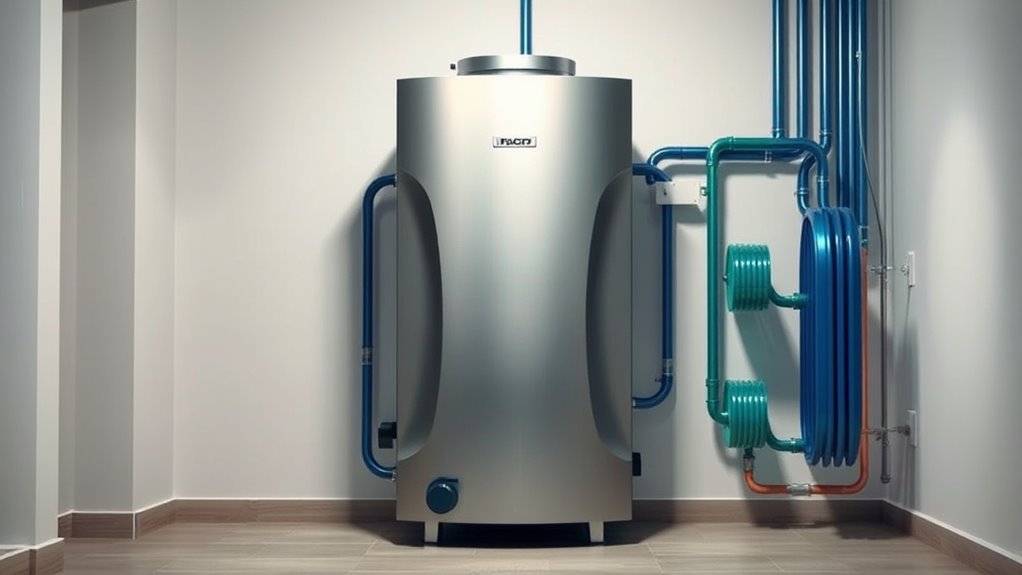
Heat pump water heaters (HPWHs) are more efficient than traditional electric or gas models because they transfer heat from the surrounding air rather than generate it directly. This process boosts efficiency by leveraging ambient heat, achieving about three times the efficiency of conventional systems. Here’s what makes them stand out:
Heat pump water heaters transfer ambient heat, offering three times the efficiency of traditional models.
- They use metrics like UEF and PCOP to measure performance, with ENERGY STAR models reaching up to 3.80 UEF—about four times more efficient.
- The refrigerant cycle absorbs heat from air through coils, then transfers it to water, reducing electrical use.
- Efficiency peaks between 40 °F and 90 °F ambient temperatures, maximizing heat extraction.
- Features like digital controls and backup elements optimize performance, ensuring reliable hot water while saving energy.
- Understanding trademark protections can help manufacturers safeguard innovative features and maintain competitive advantages.
Overcoming Barriers and Raising Consumer Awareness
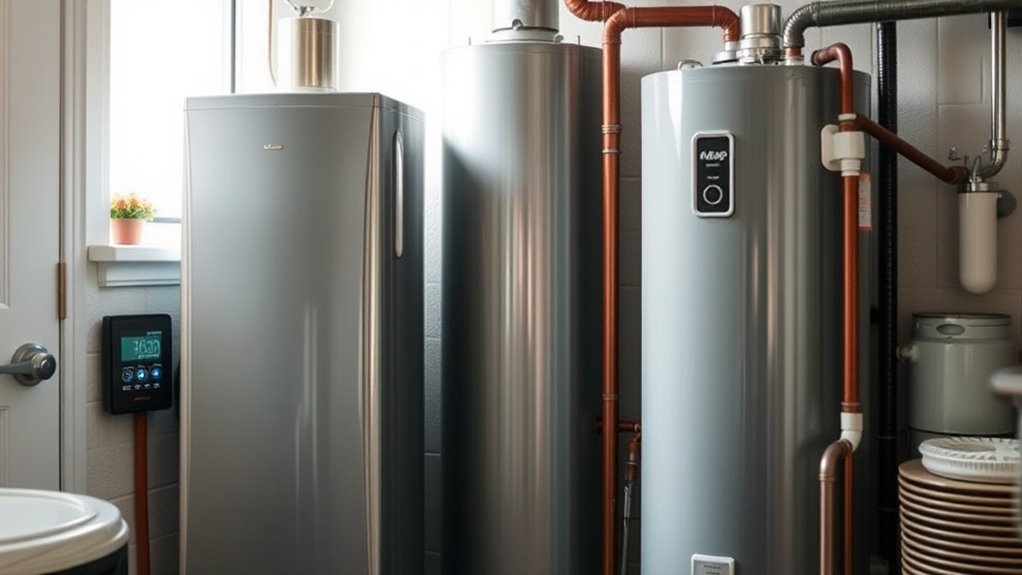
Addressing the economic and awareness barriers is essential to accelerating the adoption of heat pump water heaters (HPWHs). The high upfront costs deter many, especially low- and moderate-income households, with about 43% citing expense concerns. Incentives like rebates, low-interest loans, and support for installers can make HPWHs more affordable and attractive. Raising awareness is equally vital, as many consumers and installers lack understanding of the technology’s benefits. Education campaigns and targeted messaging can dispel misconceptions and highlight energy savings. Installer training programs improve recommendations and installations, especially in challenging climates. Overcoming behavioral resistance involves demonstrating reliability and addressing perceived hassles. Heating water accounts for 20% of home energy use in the U.S. Policy support, incentives, and ongoing education are key to transforming market perceptions and encouraging widespread adoption of HPWHs. Additionally, providing clear information about the potential cost savings over time can motivate more consumers to choose this energy-efficient option.
Frequently Asked Questions
How Long Do Heat Pump Water Heaters Typically Last?
You’re probably wondering how long a heat pump water heater lasts. Typically, you can expect it to serve you for about 13 to 15 years. With proper maintenance, like yearly inspections and replacing anode rods, you might extend its lifespan beyond that. Good water quality and correct installation also help. Taking care of it guarantees you get the most out of your investment before needing a replacement.
Are HPWHS Suitable for Small or Compact Homes?
Like a trusty steamboat steering tight waters, your heat pump water heater (HPWH) can suit small or compact homes if space, ventilation, and capacity match your needs. You’ll want enough room for efficient operation and proper airflow, possibly requiring professional help. Choose a size that fits your hot water demand, and consider models with backup elements. With proper setup, HPWHs can save energy and reduce bills in smaller homes.
What Maintenance Is Required for Optimal HPWH Performance?
To keep your heat pump water heater running efficiently, you need to inspect and clean key components regularly. Check the air filter every 6 to 12 months, more often if it’s dusty. Clean condenser coils and drain lines yearly. Monitor the thermostat and control systems, and verify proper ventilation. Also, inspect pipes for leaks, insulate hot water lines, and follow the manufacturer’s maintenance guide to prevent breakdowns and high bills.
Can HPWHS Be Used in Cold Climates Effectively?
Can HPWHs be used effectively in cold climates? Absolutely! Modern cold climate heat pumps are engineered to conquer even the most frigid temperatures, operating reliably down to -25°F. They pull heat from the cold air, turning icy conditions into energy savings. With advanced compressor technology and smart defrost cycles, these units deliver hot water year-round without breaking a sweat—saving you money and reducing emissions, even in the harshest winters.
Do Noise Levels Differ Significantly Between Models?
You might wonder if noise levels differ markedly between models. Generally, they do, with some producing quieter operation at around 45 dBA, comparable to a soft conversation, while others reach up to 60 dBA, similar to a dishwasher’s hum. Factors like brand, design, and installation location influence noise output. Choosing ENERGY STAR-rated models and proper placement, such as in a garage or basement, helps minimize noise impact.
Conclusion
Switching to heat pump water heaters can cut your energy bills by up to 60%, saving you hundreds each year. With their rising popularity — a recent report shows a 50% market growth in just two years — it’s clear these silent giants are transforming home efficiency. Don’t let high energy costs drain your wallet; embrace the tech that’s not only eco-friendly but also budget-friendly. Your wallet and the planet will thank you.
I’m Theodore, and I love tiny houses. In fact, I’m the author of Tiny House 43, a book about tiny houses that are also tree houses. I think they’re magical places where imaginations can run wild and adventures are just waiting to happen.
While tree houses are often associated with childhood, they can be the perfect adult retreat. They offer a cozy space to relax and unwind, surrounded by nature. And since they’re typically built on stilts or raised platforms, they offer stunning views that traditional homes simply can’t match.
If you’re looking for a unique and romantic getaway, a tree house tiny house might just be the perfect option.
